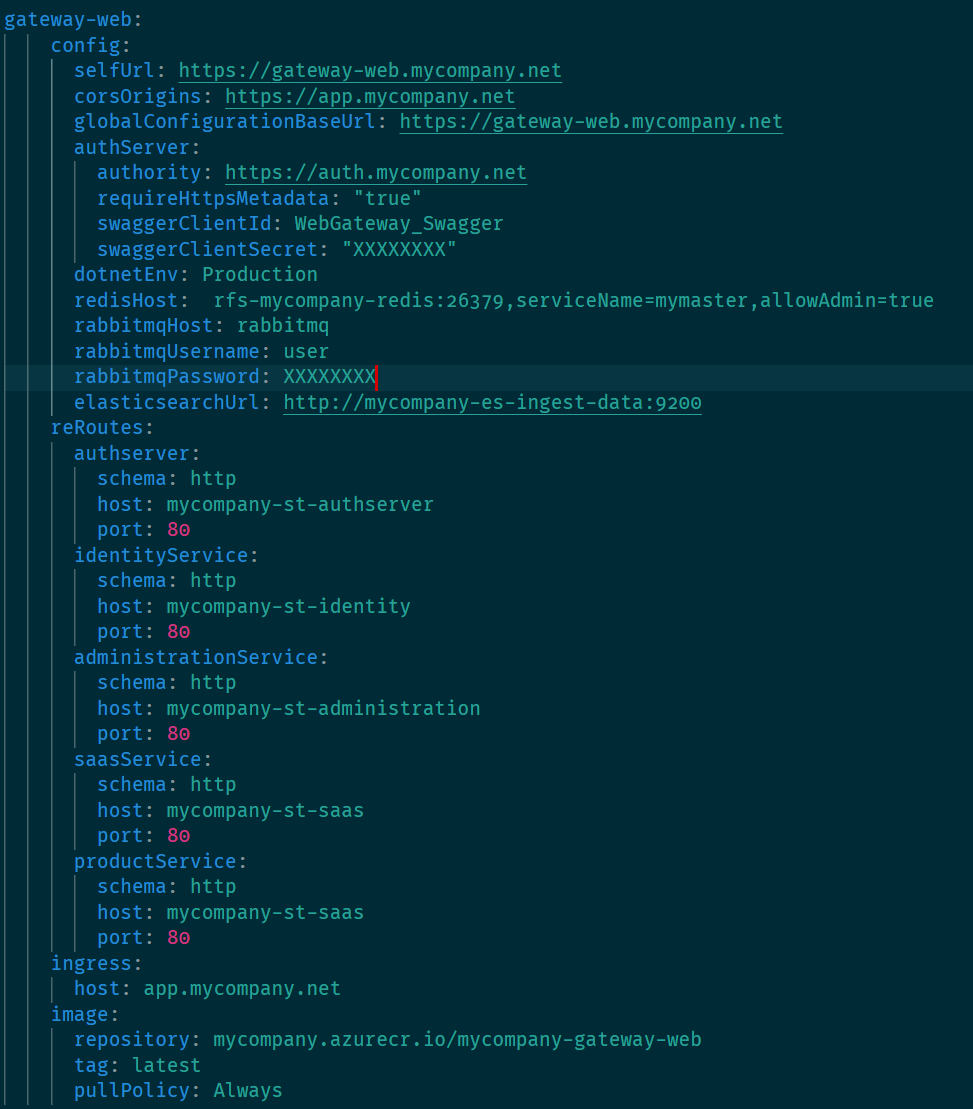Activities of "thedatacrew"
Here you go, it still doesn't work with the custom sign in manager that causes the issue. CustomSignInManager talks remotely to the NetworkSecurityService via HTTP API to fetch IP Address Permissions for the Tenant. Could it be this that causes the AuthServer to raise the error?
It all works locally though.
using System;
using System.Collections.Generic;
using System.IO;
using System.Linq;
using System.Security.Cryptography.X509Certificates;
using Microsoft.AspNetCore.Authentication.Google;
using Microsoft.AspNetCore.Authentication.MicrosoftAccount;
using Microsoft.AspNetCore.Authentication.Twitter;
using Microsoft.AspNetCore.Builder;
using Microsoft.AspNetCore.Cors;
using Microsoft.AspNetCore.DataProtection;
using Microsoft.AspNetCore.Hosting;
using Microsoft.AspNetCore.Identity;
using Microsoft.Extensions.Configuration;
using Microsoft.Extensions.DependencyInjection;
using Microsoft.Extensions.DependencyInjection.Extensions;
using Microsoft.Extensions.Hosting;
using MyCompany.AdministrationService.EntityFrameworkCore;
using MyCompany.IdentityService.EntityFrameworkCore;
using MyCompany.NetworkSecurityService;
using MyCompany.SaasService.EntityFrameworkCore;
using MyCompany.Shared.Hosting.AspNetCore;
using OpenIddict.Server.AspNetCore;
using Prometheus;
using Serilog;
using StackExchange.Redis;
using Volo.Abp;
using Volo.Abp.Account;
using Volo.Abp.Account.Public.Web;
using Volo.Abp.Account.Public.Web.ExternalProviders;
using Volo.Abp.Account.Public.Web.Impersonation;
using Volo.Abp.Account.Web;
using Volo.Abp.AspNetCore.Mvc.UI.Bundling;
using Volo.Abp.AspNetCore.Mvc.UI.Theme.LeptonX;
using Volo.Abp.AspNetCore.Mvc.UI.Theme.LeptonX.Bundling;
using Volo.Abp.AspNetCore.Mvc.UI.Theme.Shared;
using Volo.Abp.Auditing;
using Volo.Abp.BackgroundJobs.RabbitMQ;
using Volo.Abp.Caching;
using Volo.Abp.Caching.StackExchangeRedis;
using Volo.Abp.Emailing;
using Volo.Abp.EventBus.RabbitMq;
using Volo.Abp.Http.Client.IdentityModel;
using Volo.Abp.Identity;
using Volo.Abp.LeptonX.Shared;
using Volo.Abp.Modularity;
using Volo.Abp.MultiTenancy;
using Volo.Abp.OpenIddict;
using Volo.Abp.UI.Navigation.Urls;
using Volo.Abp.VirtualFileSystem;
using Volo.Saas.Host;
namespace MyCompany.AuthServer;
[DependsOn(
typeof(AbpCachingStackExchangeRedisModule),
typeof(AbpEventBusRabbitMqModule),
typeof(AbpBackgroundJobsRabbitMqModule),
typeof(AbpAspNetCoreMvcUiLeptonXThemeModule),
typeof(AbpAccountPublicWebOpenIddictModule),
typeof(AbpAccountPublicApplicationModule),
typeof(AbpAccountPublicHttpApiModule),
typeof(AbpAccountPublicWebImpersonationModule),
typeof(AbpHttpClientIdentityModelModule),
typeof(AdministrationServiceEntityFrameworkCoreModule),
typeof(IdentityServiceEntityFrameworkCoreModule),
typeof(SaasServiceEntityFrameworkCoreModule),
typeof(SaasHostApplicationContractsModule),
typeof(MyCompanySharedHostingAspNetCoreModule),
typeof(MyCompanySharedLocalizationModule),
typeof(NetworkSecurityServiceHttpApiClientModule)
)]
public class MyCompanyAuthServerModule : AbpModule
{
public override void PreConfigureServices(ServiceConfigurationContext context)
{
var hostingEnvironment = context.Services.GetHostingEnvironment();
var configuration = context.Services.GetConfiguration();
PreConfigure<OpenIddictBuilder>(builder =>
{
builder.AddValidation(options =>
{
options.AddAudiences("AccountService");
options.UseLocalServer();
options.UseAspNetCore();
});
builder.AddServer(builder =>
{
if (!Convert.ToBoolean(configuration["AuthServer:RequireHttpsMetadata"]))
{
builder.UseAspNetCore().DisableTransportSecurityRequirement();
}
builder.Configure(options =>
{
var validIssuers = (configuration.GetSection("AuthServer:ValidIssuers").Get<string[]>() ?? Array.Empty<string>());
var validIssuerList = validIssuers.Select(validIssuer => validIssuer.EnsureEndsWith('/')).ToList();
options.TokenValidationParameters.ValidIssuers = validIssuerList;
Log.Information("OpenIddictBuilder TokenValidationParameters.ValidIssuers are {@ValidIssuers}", validIssuers);
});
});
});
if (!hostingEnvironment.IsDevelopment())
{
PreConfigure<AbpOpenIddictAspNetCoreOptions>(options =>
{
options.AddDevelopmentEncryptionAndSigningCertificate = false;
});
PreConfigure<OpenIddictServerBuilder>(builder =>
{
builder.AddSigningCertificate(GetSigningCertificate(hostingEnvironment, configuration));
builder.AddEncryptionCertificate(GetSigningCertificate(hostingEnvironment, configuration));
builder.SetIssuer(new Uri(configuration["AuthServer:Authority"]));
});
}
// TODO : Removing for now as it breaks auth server.
//
// PreConfigure<IdentityBuilder>(builder =>
// {
// builder.AddSignInManager<CustomSignInManager>();
// });
}
public override void ConfigureServices(ServiceConfigurationContext context)
{
var hostingEnvironment = context.Services.GetHostingEnvironment();
var configuration = context.Services.GetConfiguration();
if (!Convert.ToBoolean(configuration["App:DisablePII"]))
{
Microsoft.IdentityModel.Logging.IdentityModelEventSource.ShowPII = true;
}
if (!Convert.ToBoolean(configuration["AuthServer:RequireHttpsMetadata"]))
{
Configure<OpenIddictServerAspNetCoreOptions>(options =>
{
options.DisableTransportSecurityRequirement = true;
});
}
ConfigureBundles();
ConfigureSwagger(context, configuration);
ConfigureSameSiteCookiePolicy(context);
ConfigureExternalProviders(context);
context.Services.Configure<AbpTenantResolveOptions>(options =>
{
options.TenantResolvers.Clear();
options.TenantResolvers.Add(new CurrentUserTenantResolveContributor());
});
Configure<AbpMultiTenancyOptions>(options =>
{
options.IsEnabled = true;
});
Configure<AbpAccountOptions>(options =>
{
// For impersonation in Saas module
options.TenantAdminUserName = "admin";
options.ImpersonationTenantPermission = SaasHostPermissions.Tenants.Impersonation;
// For impersonation in Identity module
options.ImpersonationUserPermission = IdentityPermissions.Users.Impersonation;
});
Configure<AbpAuditingOptions>(options =>
{
options.ApplicationName = "AuthServer";
});
Configure<AppUrlOptions>(options =>
{
options.Applications["MVC"].RootUrl = configuration["App:SelfUrl"];
options.RedirectAllowedUrls.AddRange(configuration["App:RedirectAllowedUrls"].Split(','));
});
Configure<AbpDistributedCacheOptions>(options =>
{
options.KeyPrefix = "MyCompany:";
});
var dataProtectionBuilder = context.Services.AddDataProtection().SetApplicationName("MyCompany");
var redis = ConnectionMultiplexer.Connect(configuration["Redis:Configuration"]);
dataProtectionBuilder.PersistKeysToStackExchangeRedis(redis, "MyCompany-Protection-Keys");
context.Services.AddCors(options =>
{
options.AddDefaultPolicy(builder =>
{
builder
.WithOrigins(
configuration["App:CorsOrigins"]
.Split(",", StringSplitOptions.RemoveEmptyEntries)
.Select(o => o.Trim().RemovePostFix("/"))
.ToArray()
)
.WithAbpExposedHeaders()
.SetIsOriginAllowedToAllowWildcardSubdomains()
.AllowAnyHeader()
.AllowAnyMethod()
.AllowCredentials();
});
});
#if DEBUG
context.Services.Replace(ServiceDescriptor.Singleton<IEmailSender, NullEmailSender>());
#endif
if (hostingEnvironment.IsDevelopment())
{
Configure<AbpVirtualFileSystemOptions>(options =>
{
options.FileSets.ReplaceEmbeddedByPhysical<MyCompanySharedLocalizationModule>(Path.Combine(
hostingEnvironment.ContentRootPath,
$"..{Path.DirectorySeparatorChar}..{Path.DirectorySeparatorChar}..{Path.DirectorySeparatorChar}..{Path.DirectorySeparatorChar}shared{Path.DirectorySeparatorChar}MyCompany.Shared.Localization"));
});
}
Configure<LeptonXThemeOptions>(options =>
{
options.DefaultStyle = LeptonXStyleNames.System;
});
}
public override void OnApplicationInitialization(ApplicationInitializationContext context)
{
var app = context.GetApplicationBuilder();
var env = context.GetEnvironment();
var configuration = context.ServiceProvider.GetRequiredService<IConfiguration>();
if (env.IsDevelopment())
{
app.UseDeveloperExceptionPage();
}
app.UseAbpRequestLocalization();
if (!env.IsDevelopment())
{
app.UseErrorPage();
}
app.UseCorrelationId();
app.UseAbpSecurityHeaders();
app.UseStaticFiles();
app.UseRouting();
app.UseCors();
app.UseCookiePolicy();
app.UseHttpMetrics();
app.UseAuthentication();
app.UseAbpOpenIddictValidation();
app.UseMultiTenancy();
app.UseAbpSerilogEnrichers();
app.UseUnitOfWork();
app.UseAuthorization();
app.UseSwagger();
app.UseAbpSwaggerUI(options =>
{
options.SwaggerEndpoint("/swagger/v1/swagger.json", "Account Service API");
options.OAuthClientId(configuration["AuthServer:SwaggerClientId"]);
});
app.UseAuditing();
app.UseConfiguredEndpoints(endpoints =>
{
endpoints.MapMetrics();
});
}
private void ConfigureBundles()
{
Configure<AbpBundlingOptions>(options =>
{
options.StyleBundles.Configure(
LeptonXThemeBundles.Styles.Global,
bundle =>
{
bundle.AddFiles("/global-styles.css");
}
);
});
}
private void ConfigureExternalProviders(ServiceConfigurationContext context)
{
context.Services.AddAuthentication()
.AddGoogle(GoogleDefaults.AuthenticationScheme, _ => { })
.WithDynamicOptions<GoogleOptions, GoogleHandler>(
GoogleDefaults.AuthenticationScheme,
options =>
{
options.WithProperty(x => x.ClientId);
options.WithProperty(x => x.ClientSecret, isSecret: true);
}
)
.AddMicrosoftAccount(MicrosoftAccountDefaults.AuthenticationScheme, options =>
{
//Personal Microsoft accounts as an example.
options.AuthorizationEndpoint = "https://login.microsoftonline.com/consumers/oauth2/v2.0/authorize";
options.TokenEndpoint = "https://login.microsoftonline.com/consumers/oauth2/v2.0/token";
})
.WithDynamicOptions<MicrosoftAccountOptions, MicrosoftAccountHandler>(
MicrosoftAccountDefaults.AuthenticationScheme,
options =>
{
options.WithProperty(x => x.ClientId);
options.WithProperty(x => x.ClientSecret, isSecret: true);
}
)
.AddTwitter(TwitterDefaults.AuthenticationScheme, options => options.RetrieveUserDetails = true)
.WithDynamicOptions<TwitterOptions, TwitterHandler>(
TwitterDefaults.AuthenticationScheme,
options =>
{
options.WithProperty(x => x.ConsumerKey);
options.WithProperty(x => x.ConsumerSecret, isSecret: true);
}
);
}
private X509Certificate2 GetSigningCertificate(IWebHostEnvironment hostingEnv, IConfiguration configuration)
{
var fileName = "authserver.pfx";
var passPhrase = "XXXXXXXXXXXXX-XXXXX-XXXX-XXXX-XXXXXXXXXXX";
var file = Path.Combine(hostingEnv.ContentRootPath, fileName);
if (!File.Exists(file))
{
throw new FileNotFoundException($"Signing Certificate couldn't found: {file}");
}
return new X509Certificate2(file, passPhrase);
}
private void ConfigureSwagger(ServiceConfigurationContext context, IConfiguration configuration)
{
SwaggerConfigurationHelper.ConfigureWithAuth(
context: context,
authority: configuration["AuthServer:Authority"],
scopes: new Dictionary<string, string> {
/* Requested scopes for authorization code request and descriptions for swagger UI only */
{ "AccountService", "Account Service API" }
},
apiTitle: "Account Service API"
);
}
private void ConfigureSameSiteCookiePolicy(ServiceConfigurationContext context)
{
context.Services.AddSameSiteCookiePolicy();
}
}
I got a bit further by using the helm configmap to override the appsettings so that it uses the correct url. However i now get the following error.
Everything is running non http on k8s.
Volo.Abp.AbpException: Could not retrieve the OpenId Connect discovery document! ErrorType: PolicyViolation. Error: Endpoint does not use HTTPS: http://auth.mycompany.net/connect/authorize
Hi,
@gterdem - Is there any know fix for this yet?
Thanks
Hi,
I had a call with Galip, the PreConfigure causes an issue with OpenIddict 4, where as when we tried the Configure it's does not work at all. Waiting on a fix for this.
Hi,
After fixing the routes and retesting the following code does not load the CustomSignInManager
public override void PreConfigureServices(ServiceConfigurationContext context)
{
Configure<IdentityBuilder>(identityBuilder =>
{
identityBuilder.AddSignInManager<CustomSignInManager>();
});
}
Thanks,
Those changes to AuthServer & Blazor have worked for Tenant & User. You may want to updated the document to point out that this applicable for versions above v5 as well. Please could you credit my question back?
Regards
I'm not sure I'm following exactly, is it supported or not? There some code comments here for Web but Public Web / Angular / Blazor / Blazor Server is not supported?
I reached out to support to get some consultancy hours booked in, although it should be documented well enough to work and the charts should be of good enough quality to be able to to deploy the solution to Azure/AWS/GKE.
I understand that the Microservices demo has moved to eShop but that doesn't help the OOTB Microservices templates which seem to have been forgotten and we don't need an ecommerce solution just a simple starting point.
Pretty much just going around in circles not able to get even the basic demo app into a production K8s. Works fine with docker & Tye. There is just not enough information to get this working.
